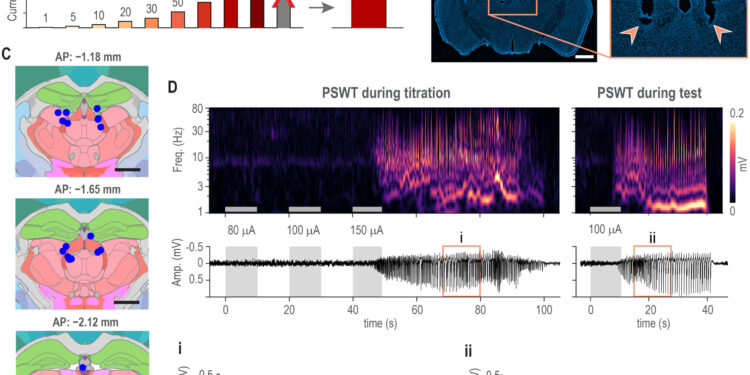Methods and examples of CT-DBS-induced PSWT. Credit: Brain stimulation (2024). DOI: 10.1016/j.brs.2024.08.002
The idea of electrically stimulating a region of the brain called the central thalamus has gained popularity among researchers and clinicians because it can help wake subjects from unconsciousness induced by head trauma or anesthesia, and can boost cognition and performance in awake animals. But the method, called CT-DBS, can have a side effect: seizures.
A new study by researchers at MIT and Massachusetts General Hospital (MGH), who tested the method on awake mice, quantifies the likelihood of seizures at different stimulation currents and warns that they sometimes occur even at low levels. Brain stimulation.
“Understanding the production and prevalence of this type of epileptic activity is important as brain stimulation-based therapies become increasingly used,” said co-senior author Emery N. Brown.
In the brain, seizures associated with DBS-CT occur as “electrographic seizures,” which are voltage discharges between neurons across a broad spectrum of frequencies. Behaviorally, they manifest as “absence seizures,” in which the subject appears to stare blankly and freeze for about 10 to 20 seconds.
In their study, the researchers hoped to determine a CT-DBS stimulation current – in a clinically relevant range of less than 200 microamps – below which seizures could be reliably prevented.
In search of this ideal current, they developed a protocol of starting brief CT-DBS sessions at 1 microamp and then gradually increasing the current to 200 microamps until they found a threshold where an electrographic seizure would occur. Once this threshold was found, they then tested a longer stimulation period at the next lowest current level in the hopes that an electrographic seizure would not occur. They did this for a variety of different stimulation frequencies.
To their surprise, electrographic seizures still occurred in 2.2% of cases during these longer stimulation trials (22 times out of 996 tests) and in 10 out of 12 mice. At just 20 microamps, the mice still experienced seizures in 3 out of 244 tests, a rate of 1.2%.
“This is something we had to report because it was really surprising,” said co-senior author Francisco Flores, an affiliated researcher at the Picower Institute and CBMM, and a professor of anesthesia at MGH, where Brown is also an anesthesiologist. Isabella Dalla Betta, a technical associate at the Picower Institute, co-led the study.
The stimulation frequency did not matter for seizure risk, but the rate of electrographic seizures increased with current level. For example, this occurred in 5 of 190 tests at 50 microamps and in 2 of 65 tests at 100 microamps. The researchers also found that when an electrographic seizure did occur, it occurred more quickly at higher currents than at lower levels.
Finally, they also observed that seizures occurred more quickly if the thalamus was stimulated on both sides of the brain rather than just one side. Some mice exhibited behaviors similar to those of an absence seizure, while others became hyperactive.
It is not clear why some mice experienced electrographic seizures at only 20 microamps while two mice did not experience seizures even at 200. Flores speculated that there may be different brain states that alter seizure predisposition when the thalamus is stimulated.
It should be noted that seizures are not typically seen in humans who receive CT-DBS while in a minimally conscious state after head trauma or in animals under anesthesia. Flores said the next step in the research would be to determine what the relevant brain states might be.
Meanwhile, the study authors wrote: “EEG should be closely monitored for possible electrographic seizures when performing CT-DBS, especially in awake subjects.”
The study’s co-senior author is Matt Wilson, Sherman Fairchild Professor in the Picower Institute, CBMM, and the Departments of Biology and Brain and Cognitive Sciences. In addition to Dalla Betta, Flores, Brown, and Wilson, the study’s other authors are John Tauber, David Schreier, and Emily Stephen.
More information:
Flores, FJ et al. Electrographic seizures during low-current thalamic deep brain stimulation in mice, Brain stimulation (2024). DOI: 10.1016/j.brs.2024.08.002. linkinghub.elsevier.com/retrie … ii/S1935861X24001396
Provided by the Massachusetts Institute of Technology
Quote:Study quantifies seizure risk by stimulating thalamus in awake mice (2024, August 21) retrieved August 21, 2024 from
This document is subject to copyright. Apart from any fair dealing for the purpose of private study or research, no part may be reproduced without written permission. The content is provided for informational purposes only.



